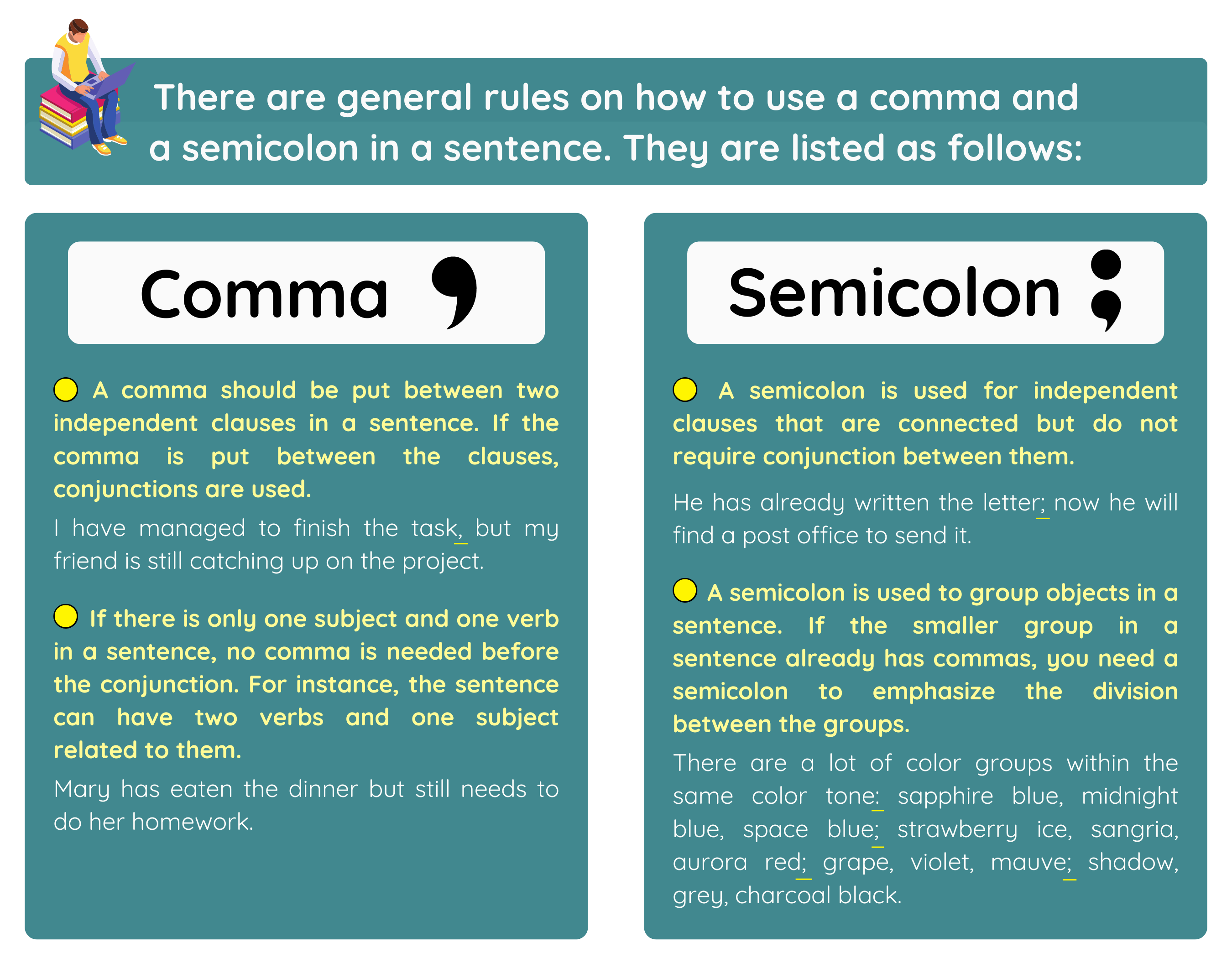Commas and Semicolons in a Sentence: Correct Punctuation
If the combination of words forms a complete sentence that has a subject and a verb, it is called an independent clause. Independent clauses can be used as a finished statement or remain connected with another independent clause. Two clauses that are related create a compound sentence. Independent clauses demand punctuation marks to be used between them. Typically, a comma or a semicolon is placed in the sentence to make it grammatically correct.
Table of contents
Comma
A comma is used after the independent clause in a sentence. In this case, two clauses are connected with the help of conjunction. Conjunctions such as but, and, for, nor, yet, so are used to articulate the meaning of the sentence. The following sentences provide an example of independent clauses being set off by commas:
- I am headed home, and I plan on being on my own for at least a few hours.
- It was hard to catch a glimpse of their silhouettes in the distance, but we managed to do just that.
- There was no way they could reach the mountain till sunset, so they figured they could stay in the village.
Semicolon
A semicolon is used for two clauses that do not have conjunction. These clauses present independent sentences that do not require conjunctive adverbs. Both parts of the sentence have similar meaning, and the clauses are interrelated:
- She will be in Lower Hutt; she will remain there until her place is renovated.
- The camera was shaking, and the image turned out to be hazy; we had a great time outside nonetheless.
- There was no way he would agree to this plan without a discussion; they decided to call a meeting in the evening.
However, there is a way to combine independent clauses other than adding a semicolon. The use of a semicolon in this case is followed by adverbial conjunction. Adverbial conjunctions can show the sequence of events along with displaying cause and effect or contrasting two items:
- They will be dining at this place; moreover, they will invite their friends.
- It didn’t look like he could finish the project on time; however, he showed his boss he was mistaken.
- The team didn’t have a spare minute to talk to the man; therefore, they promised to have a conversation after the conference.
A semicolon is also used for independent clauses that have a clear connection between them. Since both clauses present independent sentences, the connection should be emphasized within the context:
- I purchased two chocolate bars at a shop nearby; I wanted to get high on sugar and sweets.
- Material values have to be gained along with immaterial impressions; a balance needs to be maintained at all times.
- Richard was planning to tell some sort of secret; Martha was planning to have a walk.
The examples above prove that the words placed after the semicolons do not have to be written with a capital letter. Please note that both parts of the compound sentence form complete thoughts. They are combined with the help of a semicolon instead of a simple comma. A semicolon has to be used instead of a colon to avoid a comma splice. A comma splice can be interpreted as a run-on sentence, but it is better to be grammatically correct when structuring an academic text.
Semicolons and lists
Semicolons are also used to clarify the meaning of long lists or lists with punctuation between nouns. These are the cases when the punctuation marks help the audience understand the names on the list and the separation of items that are being mentioned in the text. Some of the prominent examples of this separation would be:
- We have grouped the cities according to their level of national wealth: Perth, Sydney, Canberra; Brisbane, Townsville, Cairns; Ballarat, Bendigo, Mackay.
In the example above, cities are grouped according to the criteria that have been defined in the text. Long lists are typically set off with semicolons to help clarify the context. Punctuation is considered to be tricky when it comes to combining two clauses, especially when they need to act as conjunction. By learning the rules of grammar, pertaining to commas, one can acquire the knowledge necessary to write a paper.
Comma and semicolon rules

